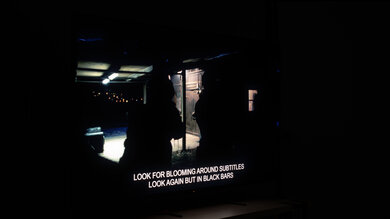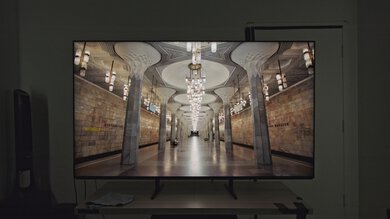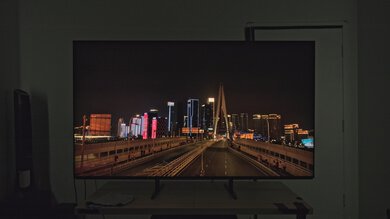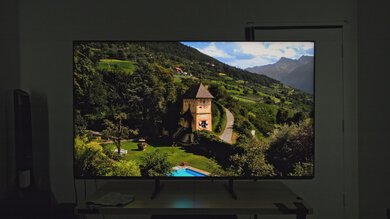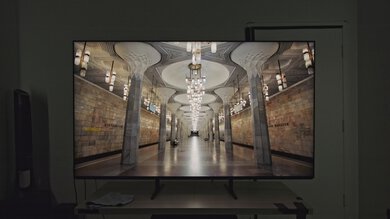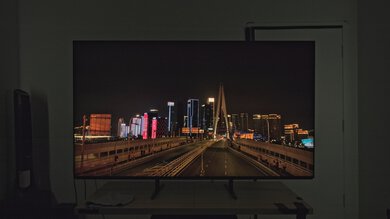The Sony BRAVIA 9 QLED is Sony's flagship TV in 2024 and is their first non-OLED flagship model since 2020. It sits above the Sony BRAVIA 7 QLED and the Sony BRAVIA 8 OLED. Sony claims they've developed the smallest LED controllers on the market, allowing for better contrast and more precise control of local dimming zones to greatly reduce the blooming around bright, small objects that LED TVs with local dimming typically have. One of Sony's main goals with the TV is to bring unity with their BVM-HX3110 mastering monitor used in post-production to master films. They want the director's vision to translate to the at-home movie-watching experience as well as possible.
The TV is packed with modern features like Dolby Vision, HDMI 2.1 bandwidth, up to 4k @ 120Hz, and VRR support. It uses the Google TV interface, which is loaded with apps and has other smart features like voice control. The TV has a built-in 70W 2.2.2 channel speaker system, and you can also use the TV as a center channel with compatible soundbars and receivers. We bought and tested the 65-inch model, but it's available in three sizes: 65-inch, 75-inch, and 85-inch.
Our Verdict
The Sony BRAVIA 9 is excellent for mixed usage. The TV gets very bright and has superb reflection handling, so it's suitable for use in a bright room. It also looks incredible in a dark room due to its exceptional contrast, and HDR content is impactful due to its incredible HDR brightness. It has modern gaming features that make it fully compatible with recent consoles, and its excellent response time delivers fast motion with minimal blur, which is great for playing video games or watching sports. Unfortunately, the TV's viewing angle is mediocre, limiting its usefulness for watching content with a large group of people.
-
Exceptional contrast delivers very deep blacks with barely any blooming.
-
Incredible HDR brightness for impactful highlights.
-
Superb SDR brightness and reflection handling means it overcomes glare in bright rooms.
-
Excellent response time for minimal blur behind fast motion.
-
Mediocre viewing angle means the image degrades when viewed from the sides.
The Sony BRAVIA 9 is great for watching TV shows. It has superb SDR brightness and reflection handling, so it easily overcomes glare in a bright room. Its impressive low-quality content smoothing means low bitrate streams or shows on cable are mostly free from distracting artifacts, and its exceptional upscaling capabilities mean DVDs or low-resolution streams don't look overly soft and still have some details. The TV is also loaded with apps, so finding the newest hit shows is very easy. Unfortunately, it has a mediocre viewing angle, making it a poor choice for watching TV with friends, as the image degrades when viewed from the sides of the screen.
-
Superb SDR brightness and reflection handling means it overcomes glare in bright rooms.
-
Exceptional upscaling capabilities.
-
Impressive low-quality content smoothing for low bitrate content.
-
Mediocre viewing angle means the image degrades when viewed from the sides.
The Sony BRAVIA 9 is great for watching sports. It has an excellent response time, so there's minimal blur behind fast-moving players and objects. The TV has superb reflection handling and SDR brightness that makes it easily overcome glare in a bright room, so you aren't distracted by reflections on the screen when watching Sunday afternoon NFL games. On the other hand, the TV only has decent gray uniformity, so you notice some dirty screen effect when watching sports like hockey with large areas of uniform color. The TV also has a mediocre viewing angle, so it's not the best choice for watching the game with a big group of friends since the image degrades when viewed from the sides of the screen.
-
Superb SDR brightness and reflection handling means it overcomes glare in bright rooms.
-
Excellent response time for minimal blur behind fast motion.
-
Exceptional upscaling capabilities.
-
Impressive low-quality content smoothing for low bitrate content.
-
Mediocre viewing angle means the image degrades when viewed from the sides.
-
Only decent gray uniformity with some noticeable dirty screen effect.
The Sony BRAVIA 9 is fantastic for playing video games. The TV pairs well with modern gaming consoles due to its HDMI 2.1 bandwidth, 4k @ 120Hz, and VRR support. You also get the best possible performance without sacrificing image quality since there's no noticeable difference when you use Game Mode. The TV's superb SDR brightness and reflection handling allow you to game in a bright room without distracting reflections. On top of that, the TV provides a responsive gaming experience due to its incredibly low input lag, and there's minimal blur behind fast motion due to its excellent response time.
-
Superb SDR brightness and reflection handling means it overcomes glare in bright rooms.
-
HDMI 2.1 bandwidth, up to 4k @ 120Hz, and VRR support.
-
Excellent response time for minimal blur behind fast motion.
-
Incredibly low input lag for a responsive experience.
-
Only supports 4k @ 120Hz on two ports.
The Sony BRAVIA 9 is outstanding for watching movies in a dark room. Its exceptional contrast delivers very deep blacks in a dark room, and blacks stay deep when bright highlights are also on screen. Highlights in HDR content pop out due to the TV's incredible HDR brightness. The colors are vibrant, lifelike, and bright due to the TV's wide color gamut and outstanding color volume, leading to an impactful HDR experience. The TV removes 24p judder, so you don't have to regularly adjust settings to get a judder-free experience. Finally, the TV has excellent SDR pre-calibration accuracy, so you don't have to get it calibrated if you care about the content creator's intent.
-
Exceptional contrast delivers very deep blacks with barely any blooming.
-
Incredible HDR brightness for impactful highlights.
-
Removes 24p judder from any source.
-
Dolby Vision & DTS audio support.
-
Exceptional upscaling capabilities.
-
Excellent SDR pre-calibration accuracy means it stays true to the filmmaker's intent.
-
Mediocre viewing angle means the image degrades when viewed from the sides.
The Sony BRAVIA 9 is fantastic for playing games in HDR. The TV's incredibly low input lag means there's no noticeable delay between your controller inputs and the action on screen, and its excellent response time means that fast motion is delivered with minimal blur. HDR games are impactful due to the TV's exceptional contrast and incredible HDR brightness, so you get very deep blacks and bright highlights that pop out. Using Game Mode doesn't affect image quality, so you don't have to compromise if you want the best possible performance. Finally, you can take full advantage of your Series X|S or PS5 with this TV due to its HDMI 2.1 bandwidth, 4k @ 120Hz, and VRR support.
-
Exceptional contrast delivers very deep blacks with barely any blooming.
-
Incredible HDR brightness for impactful highlights.
-
HDMI 2.1 bandwidth, up to 4k @ 120Hz, and VRR support.
-
Excellent response time for minimal blur behind fast motion.
-
Incredibly low input lag for a responsive experience.
-
Only supports 4k @ 120Hz on two ports.
The Sony BRAVIA 9 is excellent for use as a PC monitor. Its incredibly low input lag provides a responsive desktop experience, and fast cursor movements or other fast motion has minimal blur behind it due to its excellent response time. The TV has superb SDR brightness and reflection handling, so you can use your PC in a bright room, and you aren't distracted by reflections. The TV displays chroma 4:4:4 properly, but unfortunately, it uses a BGR subpixel layout that impacts the text clarity, although not everyone will be bothered by this. Finally, it has a mediocre viewing angle, so the sides of the screen aren't completely uniform with the center when you sit up close.
-
Superb SDR brightness and reflection handling means it overcomes glare in bright rooms.
-
Excellent response time for minimal blur behind fast motion.
-
Incredibly low input lag for a responsive experience.
-
Mediocre viewing angle means the image degrades when viewed from the sides.
-
Only decent gray uniformity with some noticeable dirty screen effect.
-
Only supports 4k @ 120Hz on two ports.
- 8.8 Mixed Usage
- 8.4 TV Shows
- 8.3 Sports
- 9.1 Video Games
- 9.0 HDR Movies
- 9.0 HDR Gaming
- 8.7 PC Monitor
- Updated Jun 14, 2024: Review published.
- Updated Jun 11, 2024: Early access published.
- Updated Jun 03, 2024: Our testers have started testing this product.
- Updated May 29, 2024: The product has arrived in our lab, and our testers will start evaluating it soon.
- Updated May 21, 2024: We've purchased the product and are waiting for it to arrive in our lab.
Differences Between Sizes And Variants
We bought and tested the 65-inch Sony BRAVIA 9, but it's also available in 75-inch and 85-inch sizes, and most of these results are valid for those sizes. The number of local dimming zones varies between sizes, so the contrast and dark room performance might be slightly different depending on which size you get. We expect the bigger sizes to have even better local dimming performance than the 65-inch.
| Size | Model Number | Local Dimming Zones |
|---|---|---|
| 65" | K-65XR90 | 1512 |
| 75" | K-75XR90 | 1920 |
| 85" | K-85XR90 | 2808 |
Our unit was manufactured in May 2024; you can see the label here.
Compared To Other TVs
The Sony BRAVIA 9 is an amazing TV and the best LED TV we've tested as of publication. Its contrast delivers incredibly deep blacks that rival OLEDs and the local dimming control on the TV keeps blooming to a minimum. It's also one of the brightest TVs on the market, so it's outstanding for use in a bright room, and it can display the brightest highlights in most HDR content. The TV displays an image that respects the content creator's intent in both SDR and HDR, so it's great for those who care most about accuracy in movies and TV shows. It's also loaded with modern gaming features, so the TV truly delivers whether you're gaming or watching content. Unfortunately, its narrow viewing angle limits its usefulness in a group setting. It's also one of the most expensive TVs on the market, and you can get OLEDs with a much wider viewing angle and even better contrast for around the same price or even cheaper. Still, some people will prefer the BRAVIA 9's advantage in overall brightness.
For more options, check out our recommendations for the best TVs for watching movies, the best LED TVs, and the best TVs.
The Sony BRAVIA 9 QLED and the LG C4 OLED are better than each other in different ways. As good as the contrast is on the Sony, the LG has it beat, so it looks a bit better in a dark room. The LG edges the Sony out regarding SDR accuracy, so it's better if you want the most accurate TV without needing calibration. The LG has a faster response time for less blur behind quick motion. It also has a wider viewing angle, so it's the better option if you regularly watch TV with a group. However, the Sony is the brighter TV overall, so it overcomes more glare in a bright room, and highlights pop out more in HDR content.
For the most part, the LG G4 OLED is better than the Sony BRAVIA 9 QLED. The Sony has very impressive contrast for an LED TV, but the LG is still better, providing even deeper blacks than the Sony with less blooming. The LG is better suited for watching TV with a big group due to its wider viewing angle. Its faster response time delivers fast motion with less blur behind it. When it comes to gaming, both TVs are great, but the LG is better due to its lower input lag, HDMI 2.1 bandwidth on all four ports, and 144Hz support for PC gamers. However, the Sony is brighter overall, so it overcomes more glare in a bright room and can display brighter highlights in HDR content.
The Sony BRAVIA 9 is better than the Sony BRAVIA 7 QLED. The BRAVIA 9 has better SDR brightness and much better reflection handling, so it overcomes more glare in a bright room. Highlights stand out more in HDR content on the BRAVIA 9 due to its better HDR brightness, and it has a better local dimming feature that provides better contrast for deeper blacks with less blooming. The BRAVIA 9 has a mediocre viewing angle, but the image holds up better from the sides of the screen than it does on the BRAVIA 7, so it's a bit better for watching TV with a group. Finally, the BRAVIA 9 has a faster response time for a bit less blur behind quick motion.
In most ways, the Sony A95L OLED is better than the Sony BRAVIA 9 QLED. The A95L has a much wider viewing angle, so it’s better if you regularly watch TV with a group. The A95L also delivers fast motion with less blur due to its faster response time. Regarding accuracy, the A95L has the BRAVIA 9 beat due to its better SDR pre-calibration accuracy and PQ EOTF tracking. However, the BRAVIA 9 is still excellent in that regard. As impressive as the contrast is on the BRAVIA 9, the A95L's is better, so it delivers deeper blacks in a dark room with no blooming whatsoever. On the other hand, the BRAVIA 9 is the brighter TV in both SDR and HDR, so highlights pop out more in HDR content, and it overcomes more glare in a bright room.
The Sony BRAVIA 9 QLED is better than the Sony X95L. The BRAVIA 9 has a much higher contrast ratio with its better local dimming feature enabled, so blacks are deeper, and there's less blooming on it. The BRAVIA 9 is also brighter overall, so it overcomes a bit more glare in a bright room, and highlights in HDR content stand out more on it, although the X95L is no slouch in that regard. The BRAVIA 9 has better PQ EOTF tracking and better SDR pre-calibration accuracy, so it sticks closer to the content creator's intent.
The Sony BRAVIA 8 OLED and the Sony BRAVIA 9 QLED are better than each other in different ways. As impressive as the contrast and local dimming control on the BRAVIA 9 is, the BRAVIA 8 is an OLED, so it provides even deeper blacks with no blooming at all. The other main advantages of the BRAVIA 8's OLED panel are its nearly instantaneous response time and much wider viewing angle. However, the BRAVIA 9 has a big advantage when it comes to brightness: It is much brighter in SDR, so it overcomes glare in the brightest of rooms, and it's also much brighter in HDR, so it can take better advantage of HDR content that gets incredibly bright. On top of that, the BRAVIA 9 is more accurate in SDR and HDR.
The Sony BRAVIA 9 QLED is better than the Hisense U8/U8N. As good as the contrast is on the Hisense, the Sony has it beat due to its better local dimming feature, providing deeper blacks with less blooming. The Sony is more accurate in both SDR and HDR, so it sticks closer to the content creator's intent. Regarding image processing, the Sony TV does a better job at both upscaling and low-quality content smoothing. Both TVs are great options for gaming, but the Sony has a more consistent VRR feature. On the other hand, the Hisense has lower input lag and 144Hz support for PC gamers.
The Sony BRAVIA 9 QLED is better than the TCL QM8/QM851G QLED. The Sony has better black uniformity and a better local dimming feature that gives it a higher contrast ratio, so it displays deeper blacks with less blooming. When it comes to accuracy, the Sony is a lot better in both SDR and HDR, so you get an image that is closer to the content creator’s intent, regardless of the format of the content. The Sony has better image processing, so low-quality and low-resolution content looks better on it, and colors have less banding. Both TVs don’t have the widest viewing angle, but the Sony’s is wider, so the image doesn’t degrade as quickly from the sides of the screen. On the other hand, the TCL gets brighter in HDR, so it can display some very bright highlights in HDR that the Sony can’t.
Video
Test Results
The TV uses two metal feet that you can adjust to four different positions in total. You can have the feet close together in a narrow position or further apart from each other in a wider position. On top of that, you can set the feet to a low or high position, depending on your needs. The low position lifts the TV about 1.34 inches, so it sits very close to your table. The high position (pictured above) lifts the TV about 3.74 inches, so almost any soundbar fits underneath without blocking the screen.
Footprint of the 65-inch stand in the narrow position: 18.82" x 13.78".
Footprint of the 65-inch stand in the wide position: 55.83" x 13.78".
The back of the TV is made entirely of plastic and has the familiar checkerboard pattern similar to many other recent Sony TVs. The inputs are on the far left side of the TV when facing the front, so they're accessible if you have the TV mounted flush to the wall. There are also plastic covers to hide the inputs section and partially hide the feet. You can also run cables through the TV's feet to help with cable management. On top of that, the TV comes with cable ties to help manage cables further.
The Sony BRAVIA 9 has exceptional contrast. Its native contrast is alright, but with local dimming on 'High,' the TV's contrast ratio delivers incredibly deep blacks that rival those found on OLEDs. Blacks also stay deep when bright highlights are also on screen.
The TV's blooming performance is outstanding. There's only a tiny bit of blooming around bright objects and subtitles when they're displayed against a black background. It's so subtle that it's barely noticeable with most content, but there's some noticeable blooming that bleeds into the black bars of letterboxed movies during very bright scenes. There's also more apparent blooming when watching the TV from an angle. Finally, there's considerable blooming across the entire screen if you open any settings menu, even when hitting the volume buttons on the remote.
The TV has remarkable lighting zone transitions. The leading edge of bright and quick-moving objects is a bit dimmer, and there's some minor haloing, but neither of these are noticeable with most real content.
The Sony BRAVIA 9 has incredible HDR brightness. Highlights really pop out during darker scenes, and the TV is bright enough that very bright specular highlights even stand out in well-lit scenes. Combined with its exceptional contrast, this TV provides a very impactful HDR viewing experience with all HDR content.
These measurements are after calibrating the HDR white point with the following settings:
- HDR Picture Mode: Professional
- Brightness (HDR): Maximum
- Contrast (HDR): 90
- Color Temperature: Expert 2
- Peak Luminance: High
- Auto Local Dimming (HDR): High
- HDR Tone Mapping: Gradation Preferred
Results with Advanced Contrast Enhancer set to 'On':
- Hallway Lights: 948 cd/m²
- Yellow Skyscraper: 754 cd/m²
- Landscape Pool: 550 cd/m²
Most scenes are slightly dimmer in Game Mode, but it's not noticeable. Highlights still pop out during darker moments in games, and it's still bright enough that very bright specular highlights stand out in well-lit scenes. Combined with its exceptional contrast, this TV provides a very impactful HDR gaming experience.
These measurements are after calibrating the HDR white point with the following settings:
- HDR Picture Mode: Game
- Brightness (HDR): Maximum
- Contrast (HDR): 90
- Color Temperature: Expert 2
- Peak Luminance: High
- Auto Local Dimming (HDR): High
- HDR Tone Mapping: Gradation Preferred
The Sony BRAVIA 9 has superb PQ EOTF tracking. The TV tracks the curve incredibly close, besides some shadows and midtones being slightly too dark and some highlights being slightly too bright. The TV is bright enough to display content mastered at 600 and 1000 nits, so no roll-off is necessary. With content mastered at 4000 nits, the gradual roll-off near the TV's maximum brightness helps to preserve details in specular highlights.
The Sony BRAVIA 9 has superb SDR brightness and easily overcomes glare in even the brightest of rooms.
These measurements are after calibration with the following settings:
- Picture Mode: Professional
- Brightness (SDR): Maximum
- Contrast (SDR): 90
- Gamma (SDR): 0
- Color Temperature: Expert 1
- Peak Luminance: High
- Auto Local Dimming (SDR): High
The Sony BRAVIA 9 has an excellent HDR color gamut. Its coverage of the commonly used DCI-P3 color space is fantastic, and colors are mostly accurate, but highly saturated greens, yellows, and reds are a bit undersaturated. Its coverage of the wider Rec. 2020 color space that's mostly used in some nature documentaries and animated films is good, but all colors are undersaturated and/or off the mark, with greens, cyans, and blues faring the worst.
The TV has outstanding color volume. It displays a wide range of colors at high luminance levels, and dark, saturated colors are displayed well due to its exceptional contrast.
The Sony BRAVIA 9 has excellent SDR pre-calibration accuracy. The color temperature is close to perfect, and gamma is very close to our target of 2.2, but all scenes are displayed brighter than intended. The white balance is very good, but blues and reds are a bit overrepresented in most shades of gray. The color accuracy is fantastic, but whites are a bit inaccurate. Fortunately, there are only very minor inaccuracies in some other colors.
The TV has even better SDR accuracy after calibration. The white balance, gamma, and color temperature are essentially perfect. Color accuracy is even better, and inaccuracies in whites are mostly gone. Other colors are still slightly off, but they're close enough that it's not noticeable with real content.
You can see our full calibration settings here.
Unfortunately, the Sony BRAVIA 9 only has decent gray uniformity. There's noticeable dirty screen effect towards the center of the screen, and the edges of the screen are darker than the middle. Its uniformity is excellent on a very dark or near-black screen, but the edges are lighter than the center. Gray uniformity is unique to each individual panel, so it's possible that other units look better than ours.
The TV's black uniformity is outstanding. With local dimming disabled, the screen is blueish and cloudy. With local dimming enabled, the blacks are deep and uniform across the screen, and there's only a tiny bit of blooming around bright objects on a dark background.
The Sony BRAVIA 9 has a mediocre viewing angle. The image looks mostly consistent from a slight angle, but there's gamma shifting, the black levels raise, and there's color washout that worsens the further you move off-center. The image is noticeably degraded at an aggressive angle, so the TV isn't a very good choice for a wide seating arrangement.
The Sony BRAVIA 9 has superb reflection handling. Its glossy coating does an outstanding job at reducing the intensity of direct reflections, and a great job at reducing the intensity of indirect reflections. Unfortunately, there's noticeable rainbow smearing. Still, combined with the TV's superb SDR brightness, it easily overcomes glare in bright rooms.
The TV has impressive HDR native gradient handling. There's noticeable banding in brighter blues, but all other colors have minimal or no banding at all.
The TV does an exceptional job with upscaling low-resolution content like DVDs, standard definition cable channels, or lower-resolution streams. Details are well-defined and clear enough, but very fine details and small hard-coded text are a bit hard to make out.
Sharpness processing was calibrated with no over-sharpening for low-resolution content, with the following settings:
- Sharpness: 60
- Reality Creation: Auto
The TV uses a BGR (Blue-Green-Red) subpixel layout instead of the traditional RGB layout. For video or gaming content, this doesn't cause any issues, but for PC monitor use, it can be a problem as it impacts the text clarity, although not everyone will notice this.
The TV uses pulse width modulation (PWM) to control the backlight intensity. With local dimming enabled, it flickers at 720Hz in all picture modes, which is high enough that it isn't noticeable, but it can still bother those sensitive to flicker.
With local dimming disabled, the TV flickers at 720Hz with the brightness set to '34' or below. With the brightness set above '34,' it has 720Hz blips that are unnoticeable.
There's an optional backlight strobing feature, commonly known as black frame insertion, which you can enable to improve the appearance of motion. Unfortunately, the image is blurry and there's some image duplication.
The Sony BRAVIA 9 has an optional motion interpolation feature to improve the clarity of motion. It works well with smoothing out motion in slower-moving scenes. Unfortunately, it doesn't work well in faster-moving scenes, and there are noticeable artifacts and a stutter-like effect in the background.
Due to the TV's quick response time, there's some noticeable stutter when watching movies or TV shows, and it's most apparent in slow panning shots.
This TV removes judder automatically from 24p sources, like a Blu-ray player or an external streaming device with a 'Match Frame Rate' feature. For 60Hz sources, like a cable box or the native apps, Motionflow has to be enabled, with both sliders at 'Min' and CineMotion set to 'High' to remove judder.
The Sony BRAVIA 9 supports HDMI Forum VRR and G-SYNC but doesn't support FreeSync. It works well across a wide refresh rate range and supports sources with Low-Frame-Compensation (LFC), which ensures your games remain nearly tear-free even when your frame rate drops very low.
This TV has incredibly low input lag when set into Game Mode, which ensures a very responsive gaming experience with very little delay between your actions with your controller or mouse and the action on-screen. It's worth noting that despite the TV having low enough input lag that you don't feel any delay while gaming, it's a bit higher than most higher-tier models from other manufacturers.
Outside of game mode, the TV's input lag is much higher, and there's a noticeable delay when hitting buttons on the remote, like when pausing a movie.
The Sony BRAVIA 9 supports all common resolutions up to 4k @ 120Hz on two of its four HDMI ports. Chroma 4:4:4 signals are displayed properly with all supported resolutions when the TV's 'Content Type' is set to Game or PC, which is important for text clarity. Unfortunately, the TV doesn't support 1440p.
With the exception of 1440p, the TV is fully compatible with everything the PS5 offers, like 4k @ 120Hz, as well as HDMI Forum VRR. It also supports Auto Low Latency Mode, so you don't have to manually switch to Game Mode to get the lowest input lag.
With the exception of 1440p, the TV is fully compatible with everything the Xbox Series X|S offers, including 4k @ 120Hz, HDMI Forum VRR, FreeSync Premium Pro, and Dolby Vision gaming. It also supports Auto Low Latency Mode, so you don't have to manually switch to Game Mode to get the lowest input lag.
The Sony BRAVIA 9 has HDMI 2.1 bandwidth on HDMI ports 3 and 4, with both supporting up to 4k @ 120Hz. Unfortunately, HDMI 3 is also the eARC port, so you lose a high bandwidth port when you plug a soundbar into the TV. The TV supports Dolby Vision, and it has an ATSC 3.0 tuner, so you can watch 4k content over-the-air.
Like some previous Sony TVs, you can use the TV's built-in speakers as a center channel when paired with a soundbar or receiver. Unfortunately, it only has Sony's S-Center input and doesn't have traditional speaker inputs like the Sony A95L OLED does, so it's only compatible with certain soundbars and receivers made by Sony.
The TV supports eARC, which lets you pass high-quality, uncompressed audio to a compatible receiver or soundbar through an HDMI cable. It supports all major audio formats, so you don't have to worry about compatibility with external sources.
The Sony BRAVIA 9 has a very good frequency response. It produces some bass, but it's not enough for impactful bass. Fortunately, the TV's sound profile is well-balanced, making dialogue easy to understand. The TV gets pretty loud and even remains well-balanced near and at max volume, which is great.
The TV has good distortion performance. There's no audible distortion at moderate volume levels, and although the distortion increases a bit as you raise the volume, it's only audible at maximum volume.
The Sony BRAVIA 9 uses version 12 of the popular Google TV operating system, and the interface is smooth and easy to use. Sometimes settings get stuck and changing values doesn't do anything. However, this is rare, and you can fix it by restarting the TV.
The TV has a fantastic selection of apps, so finding your favorite content is easy. You can also cast content from your phone using the built-in AirPlay 2 or Chromecast or play videos directly from a USB stick.
The remote is backlit and has a matte finish with blue speckles. Outside of that, the remote is identical to the one included with last year's Sony X95L. It has buttons for popular streaming services, and you can use the built-in microphone to switch inputs, change apps, search within apps, ask for the weather and time, and change settings like brightness.










